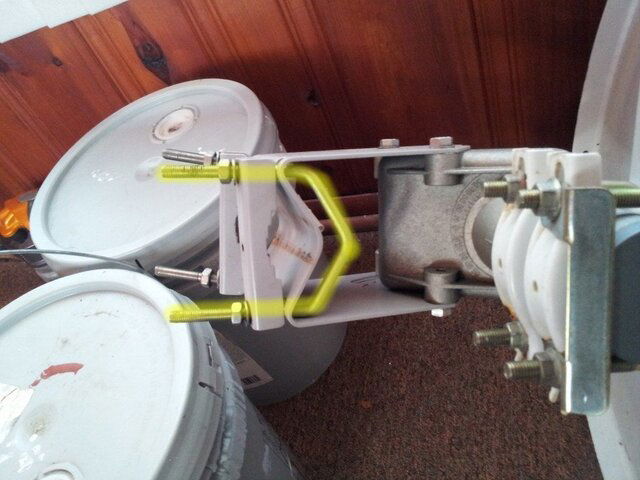Looking for FTA dish mounting hardware
- Thread starter Todd Wiedemann
- Start date
- Latest activity Latest activity:
- Replies 7
- Views 2K
You are using an out of date browser. It may not display this or other websites correctly.
You should upgrade or use an alternative browser.
You should upgrade or use an alternative browser.
- Status
- Please reply by conversation.
Looks to me like your brackets are fine, but the nuts are locked into the threads.
Ill assume they aren't cross threaded and the threads are still intact...
But if they are, some have bought threaded rod and made their own replacements
Have you tried PB Blaster on the nuts?
It's a super penetrating oil we all use to get things apart.
As a last thought, you can apply a torch to the nuts for a few seconds.
When you put it all back together, use a dab of antisieze compound to prevent future problems.
edit: some motor manufacturers have replacement hardware.
What brand is yours?
Ill assume they aren't cross threaded and the threads are still intact...
But if they are, some have bought threaded rod and made their own replacements
Have you tried PB Blaster on the nuts?
It's a super penetrating oil we all use to get things apart.
As a last thought, you can apply a torch to the nuts for a few seconds.
When you put it all back together, use a dab of antisieze compound to prevent future problems.
edit: some motor manufacturers have replacement hardware.
What brand is yours?
You can also cut the nuts in 1/2 by cutting along the axis of the thread down to the thread from opposite sides of the nut. Get (a) new nut(s) and apply anti-sieze as per Anole. This is a common problem with stainless steel threads.
Bob
Bob
If they are stainless they won't be corroded in place. They'd likely be galled. I'd put some lubricant/penetrant on like PB Blaster then take them off with a box end wrench or deep socket. You want good nut engagement so they won't round off, then turn until they either turn or twist off the rod..
What brand is yours?
judging by the pic its a STAB HH120. the u-bolts,washers & nuts on my 2 HH120's are stainless steel.
I believe stainless steel is fairly succeptable to galling.
This page describes the problem, and several solutions.
http://www.estainlesssteel.com/gallingofstainless.html
Exerpt:
This page describes the problem, and several solutions.
http://www.estainlesssteel.com/gallingofstainless.html
Exerpt:
Thread galling seems to be the most prevalent with fasteners made of stainless steel, aluminum, titanium, and other alloys which self-generate an oxide surface film for corrosion protection. During fastener tightening, as pressure builds between the contacting and sliding thread surfaces, protective oxides are broken, possibly wiped off, and interface metal high points shear or lock together. This cumulative clogging-shearing-locking action causes increasing adhesion. In the extreme, galling leads to seizing - the actual freezing together of the threads. If tightening is continued, the fastener can be twisted off or its threads ripped out.
Some SS varieties are more prone to galling, especially when they are used with another piece of the same alloy type. Differing material specs for the nut and bolt can help.
It looks like one of the threaded rods is stripped out just above the nut already. I'd just plan to replace the rod with a piece of threaded rod and move on.
It looks like one of the threaded rods is stripped out just above the nut already. I'd just plan to replace the rod with a piece of threaded rod and move on.
- Status
- Please reply by conversation.
Similar threads
- Replies
- 3
- Views
- 612
- Replies
- 20
- Views
- 840
- Replies
- 11
- Views
- 1K
- Replies
- 3
- Views
- 931
Users Who Are Viewing This Thread (Total: 0, Members: 0, Guests: 0)
Who Read This Thread (Total Members: 1)
Latest posts
-
-
-
TAI is NOT Bad: The TRUTH About Open Source LLMs #shorts
- Latest: TWiT Tech Podcast Network


